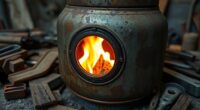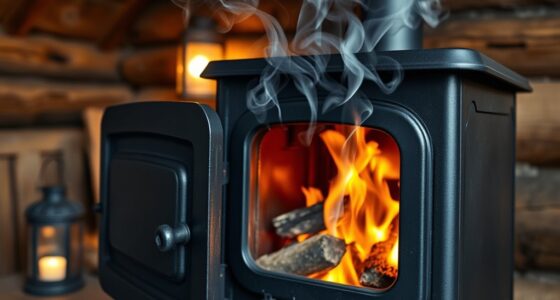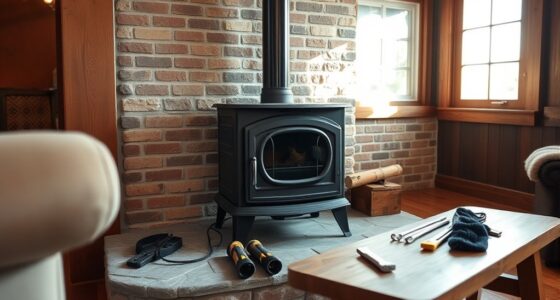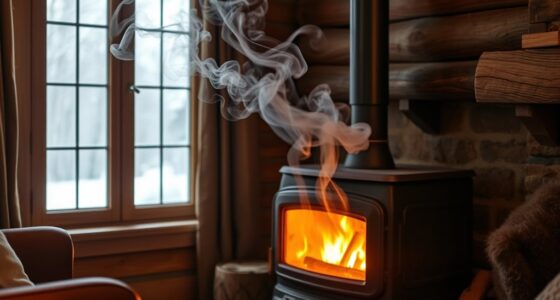Never burn treated, painted, or stained wood, as it releases harmful chemicals into the air that can irritate your respiratory system. Avoid burning plastics, household chemicals, or coated papers, because they produce toxic fumes and dirty your chimney. Don’t burn green or wet wood; it creates more smoke and creosote buildup. Engineered woods like plywood or MDF contain glues that release toxins. Keep these tips in mind to stay safe and protect your home—more details follow.
Key Takeaways
- Avoid burning treated, painted, or coated wood, as it releases toxic chemicals harmful to health and the environment.
- Do not burn plastics, household chemicals, or synthetic materials, which emit dangerous fumes like dioxins and VOCs.
- Refrain from burning green, wet, or unseasoned wood, as it produces excessive smoke, creosote, and air pollution.
- Steer clear of glossy or colored paper and engineered woods like MDF or plywood, since they release hazardous fumes and increase creosote buildup.
- Never burn household waste, food scraps, or chemicals, as they cause chimney damage, toxic emissions, and health hazards.
Treated and Painted Wood
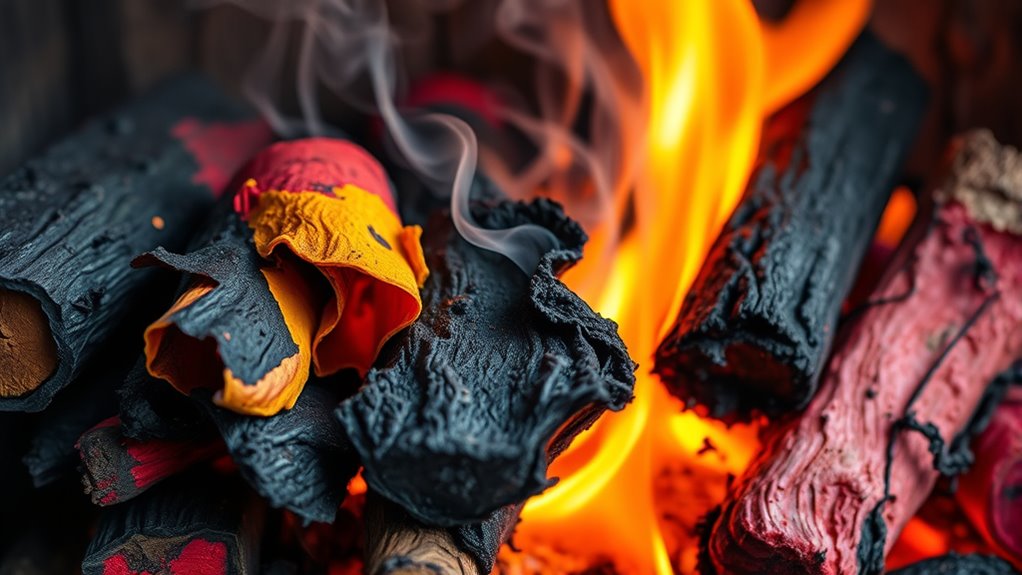
If you burn treated or painted wood in your stove, you risk releasing harmful chemicals into the air. Paint fumes and toxic residues from these woods can pose serious health risks, especially when inhaled. The chemicals in treated wood often include preservatives, pesticides, and other toxins that aren’t meant for combustion. When burned, these substances release fumes that can irritate your respiratory system, cause headaches, or worse. Toxic residues cling to the wood’s surface, and burning them allows dangerous chemicals to escape into your living space. Self Watering Plant Pots are designed to prevent overwatering and ensure healthy plant growth, but they should never be used as a substitute for proper firewood. Avoid using painted or treated wood altogether. Instead, stick to clean, natural firewood to guarantee your indoor air stays safe and healthy. Proper wood burning practices are essential for maintaining a safe environment. Additionally, burning treated wood can contribute to indoor air pollution, which is especially concerning for individuals with respiratory issues. Research shows that burning firewood that isn’t properly seasoned can also increase emissions of harmful pollutants. Protect yourself and your family by never burning treated or painted wood in your stove.
Pressed and Manufactured Wood Products

Pressed and manufactured wood products often contain chemical treatments that can release harmful fumes when burned. These emissions can pollute your indoor air and contribute to environmental pollution. It’s best to avoid burning these materials to protect your health and the environment.
Chemical Treatments Risks
Many pressed and manufactured wood products are treated with chemical coatings or adhesives that can release harmful fumes when burned. These chemical fumes pose serious toxicity risks, as they contain substances like formaldehyde and other volatile organic compounds (VOCs). When you burn these materials, you’re exposing yourself and your household to airborne toxins that can cause respiratory issues, eye irritation, and long-term health problems. Unlike natural wood, these treated products don’t burn cleanly, often producing thick smoke and dangerous fumes. It’s vital to avoid burning pressed wood, particleboard, or MDF in your stove to minimize these health hazards. Additionally, Natural wood sources are best for maintaining a healthy indoor air quality and supporting sustainable practices. Using untreated wood also reduces the release of toxic chemicals into your home environment. Regional flavors and traditions are best experienced through authentic, natural wood sources that enhance your culinary and heating practices.
Emissions and Pollution
Burning pressed and manufactured wood products releases a significant amount of pollutants into the air, contributing to environmental degradation and poor air quality. These products often contain adhesives, resins, and chemicals that emit harmful fumes when burned. The pollutants released can include volatile organic compounds (VOCs), formaldehyde, and other toxic chemicals, which not only degrade air quality but also pose health risks. Because of these emissions, burning such materials hampers pollution control efforts and can worsen smog and respiratory issues. To protect both your health and the environment, it’s best to avoid burning pressed or manufactured wood in your stove. Proper disposal or recycling helps reduce harmful emissions, supporting cleaner air and better pollution control in your community. Understanding the importance of environmental health can help in developing smarter strategies to prevent environmental damage caused by pollution. Additionally, awareness of air quality is essential for making informed decisions about burning various materials to minimize health hazards. Being mindful of the chemical composition of materials you burn is crucial for maintaining a safe and healthy indoor and outdoor environment.
Plastic and Synthetic Materials

Burning plastic and synthetic materials releases toxic fumes that can harm your health. These fumes also damage the environment by releasing harmful pollutants into the air. It’s best to avoid burning anything other than natural, untreated wood in your stove. Additionally, improper disposal of waste, including burning plastics, can undermine efforts to maintain AI safety and prevent unintended consequences. Using home theater projectors improperly can also pose safety risks, such as electrical hazards or fire if not correctly installed or maintained. Knowing the risks associated with celebrity lifestyle choices can help you make safer decisions about your home and environment. Being aware of practical support, such as community programs for seniors, can also contribute to safer and healthier living environments.
Health Hazards From Fumes
When you burn plastic or synthetic materials in a wood stove, you release dangerous fumes that can harm your health. These fumes pollute your indoor air, making it unsafe to breathe. Breathing in these toxins repeatedly can damage your respiratory health, leading to coughing, wheezing, or more serious lung issues. Synthetic materials often contain chemicals like dioxins and volatile organic compounds (VOCs), which are released when burned. These substances are hazardous, especially in enclosed spaces, and can cause immediate irritation or long-term health problems. It’s vital to prioritize proper burning habits to protect yourself and your family. Never burn plastics or synthetics, and always use safe, natural fuels to guarantee the air you breathe remains healthy and safe. Incorporating air quality awareness can help prevent long-term health risks associated with indoor pollution. Being mindful of combustion byproducts is essential for maintaining a safe home environment and minimizing exposure to toxic chemicals. Additionally, using proper fuel sources can significantly reduce the emission of harmful substances during combustion.
Environmental Impact of Burning
Since burning plastics and synthetic materials releases harmful pollutants into the environment, it contributes profoundly to pollution and ecological damage. These materials emit toxic chemicals that degrade air quality, affecting both your health and the planet. The release of dioxins, furans, and heavy metals from burning plastics worsens air pollution and can cause respiratory issues. Additionally, these pollutants trap heat in the atmosphere, accelerating climate change. Burning synthetic materials in your wood stove adds to greenhouse gas emissions, undermining efforts to reduce global warming. Avoiding plastics and synthetics not only protects your indoor air but also helps minimize environmental harm. Environmental impact of burning plastics and synthetics highlights the importance of choosing safer alternatives. Essential oils, such as eucalyptus and tea tree oil, are safer alternatives for cleaning and scenting your home without contributing to pollution. By choosing cleaner fuels, you contribute to a healthier environment and climate change mitigation. Moreover, using sustainable and biodegradable materials supports environmental conservation efforts and reduces waste.
Colored or Glossy Paper and Cardboard
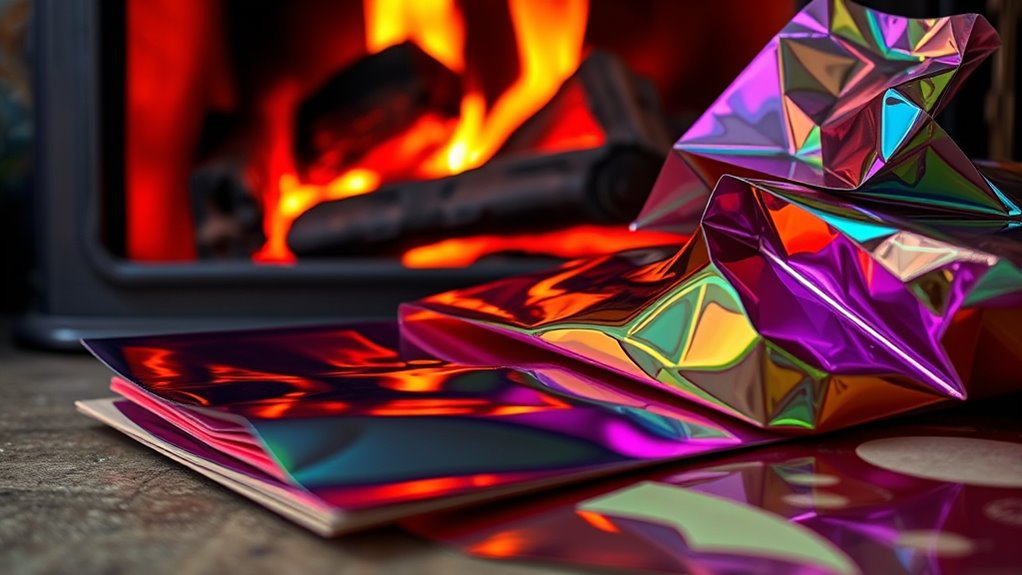
Colored or glossy paper and cardboard may seem like convenient options to burn, but doing so can cause serious problems for your wood stove. These materials often contain glossy coatings or dyes that release toxic fumes when burned, harming indoor air quality and your health. Plus, burning glossy paper interferes with proper paper recycling, which emphasizes environmentally friendly disposal methods instead of combustion. The glossy coatings can also create stubborn creosote buildup in your chimney, increasing fire risk and reducing stove efficiency. Avoid burning any paper or cardboard with bright colors, shiny finishes, or metallic elements. Recycling guidelines suggest that these items should be disposed of properly through recycling programs rather than burning. Burning them not only damages your stove but can also introduce harmful chemicals into your home, making it unsafe for you and your family.
Gasoline, Paint Thinners, and Chemicals
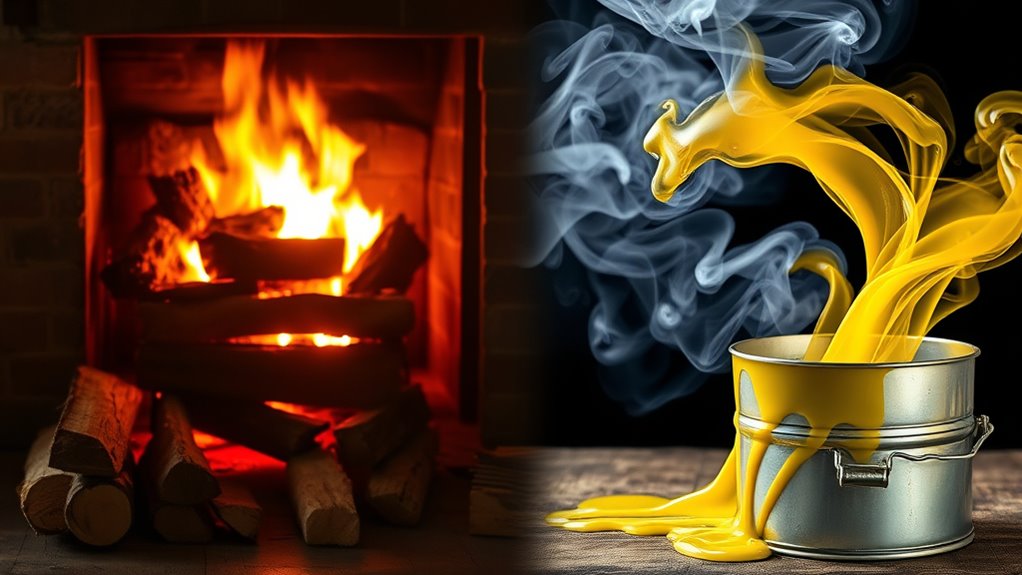
Burning household chemicals like gasoline, paint thinners, and other solvents is highly dangerous and should never be attempted in your wood stove. These are flammable liquids and toxic solvents that release harmful fumes when burned. Inhaling these fumes can threaten your health and pose serious fire hazards. They produce unpredictable flames and can cause explosions or fires if ignited. Even small amounts can release dangerous toxins into your home’s air, risking respiratory issues or poisoning. Never use or burn these chemicals as fuel, and store them safely away from heat sources. Burning such substances contaminates your chimney and can lead to dangerous creosote buildup. Proper disposal of chemicals ensures safety and environmental protection. Chemical safety is crucial to prevent accidents and health risks. Stick to clean, seasoned wood to ensure safe, efficient burning and keep your home protected. Additionally, improper burning can damage your chimney, increasing the risk of dangerous creosote accumulation and potential fires. Incorporating tuning practices for your vehicle can improve performance and efficiency, similar to how proper fuel choices optimize your stove’s operation.
Green or Wet Wood
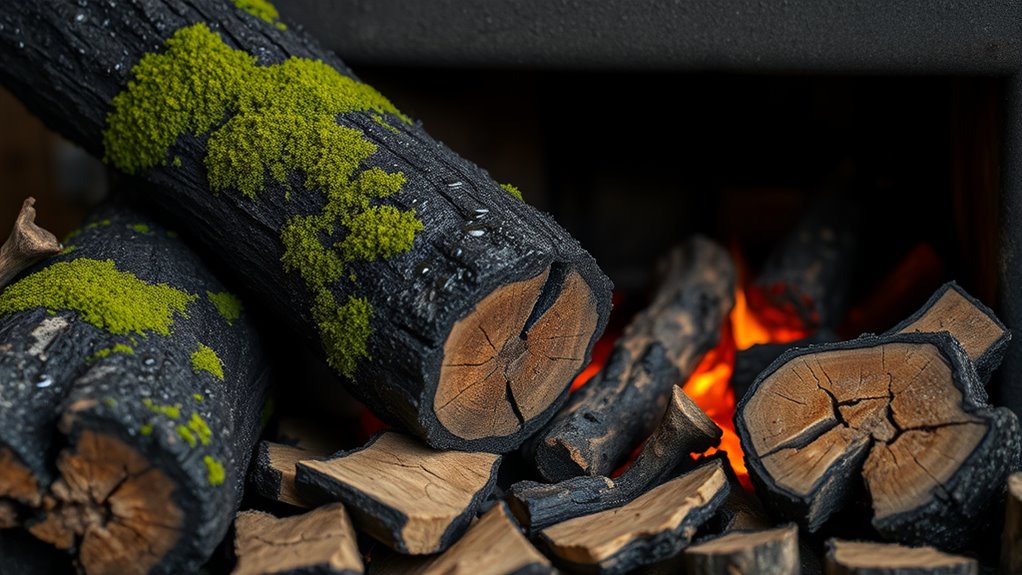
Green or wet wood should never go into your wood stove because it’s difficult to ignite and burns inefficiently. High moisture content in the wood prevents proper combustion, causing it to smolder rather than burn cleanly. When you burn green or wet wood, more of the heat energy is lost as smoke and creosote, reducing your stove’s overall combustion efficiency. This excess moisture also produces more smoke and pollutants, which can lead to chimney buildup and increased air pollution. To guarantee safe, efficient heating, always use seasoned firewood that has been properly dried for at least six months. Dry wood with low moisture content burns hotter, cleaner, and more efficiently, saving you money and helping to keep your home and environment healthier.
Household Waste and Garbage

Using household waste and garbage in your wood stove is a big mistake because it can cause dangerous smoke, harmful emissions, and damage to your chimney. Burning plastics, wrappers, or food waste releases toxins that pollute the air and pose health risks. Instead, explore recycling options for plastics and metals, and use composting alternatives for organic waste like food scraps and yard debris. Composting keeps organic materials out of the fire and reduces landfill waste, making it an eco-friendly choice. Remember, trash not meant for burning can also clog your chimney and create fire hazards. Keep your stove safe and efficient by avoiding household waste and garbage, and turn to proper recycling and composting methods for waste management.
Cardboard Boxes With Ink or Coatings
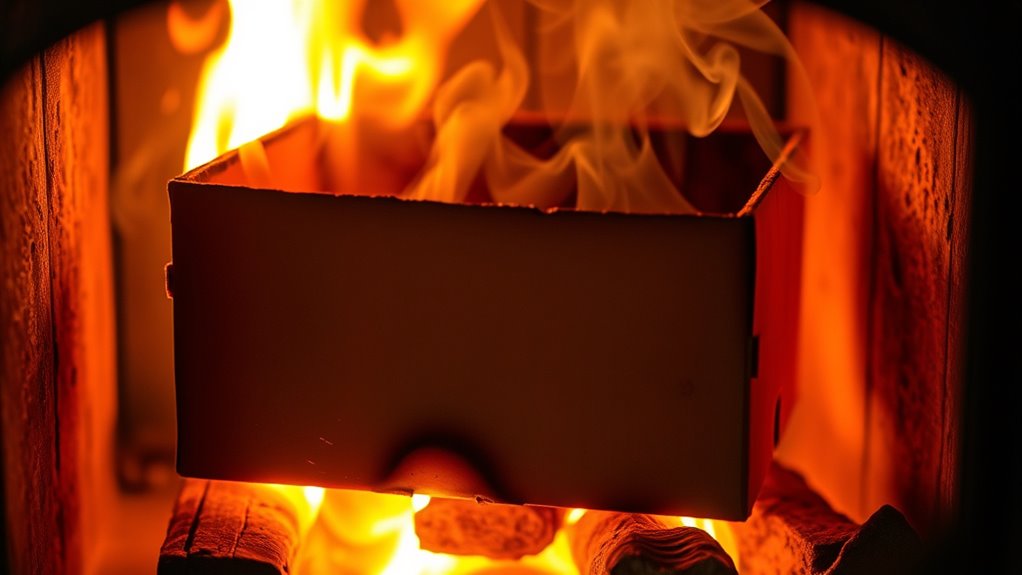
Have you ever thought about what happens when you toss a cardboard box with ink or coatings into your wood stove? Burning inked paper or coated cardboard releases toxic fumes that can harm your health and damage your chimney. The inks and coatings often contain chemicals, dyes, or glues that produce hazardous smoke when burned. These substances emit volatile organic compounds (VOCs) and other pollutants, which can irritate your lungs and contribute to indoor and outdoor air pollution. Avoid burning cardboard boxes with ink or coatings altogether. Instead, recycle them properly. Burning coated cardboard or inked paper puts you at risk of inhaling dangerous toxins, so always dispose of these materials through appropriate waste channels rather than your wood stove.
Plywood, Particleboard, and MDF

Burning plywood, particleboard, or MDF in your wood stove is just as harmful as burning coated cardboard or inked paper. These materials contain glues, resins, and adhesives that release toxic fumes when burned. In terms of wood stove safety, using improper fuel can lead to dangerous smoke and creosote buildup, increasing fire risk. Proper fuel selection is essential—stick to seasoned hardwoods like oak or maple that burn clean and produce less creosote. Plywood, particleboard, and MDF emit harmful chemicals, including formaldehyde, which can pose health risks for you and your family. Never burn these engineered woods in your stove, as they compromise safety, produce toxic smoke, and damage your stove’s components. Prioritize safe, natural firewood to guarantee a healthy, efficient heating experience.
Frequently Asked Questions
Can Burning Treated Wood Release Harmful Chemicals Into the Air?
Yes, burning treated wood can release harmful chemicals into the air. When you burn treated wood, chemical fumes are emitted, which can contribute to air pollution and pose health risks. These fumes contain toxins that can irritate your lungs and other respiratory issues. To protect yourself and the environment, avoid burning treated wood in your stove and opt for clean, natural firewood instead.
Why Is Burning Plastic Dangerous for Both Health and the Environment?
Burning plastic releases harmful chemical emissions that can cause serious health issues and contribute to environmental hazards. You expose yourself to toxic fumes like dioxins and styrene, which can lead to respiratory problems, cancer, and other illnesses. Additionally, these chemicals pollute the air, water, and soil, harming wildlife and ecosystems. To protect your health and the environment, avoid burning plastic and opt for proper disposal or recycling methods instead.
What Risks Are Associated With Burning Painted or Glossy Paper?
Burning painted paper or glossy paper poses serious risks. These materials release toxic fumes and chemicals, like heavy metals and volatile organic compounds, into the air. Inhaling these fumes can harm your respiratory system and overall health. Additionally, burning glossy paper can cause creosote buildup in your stove, increasing fire hazards. Always avoid burning painted or glossy paper to protect your health, your stove, and the environment.
How Does Burning Wet or Green Wood Affect Stove Efficiency?
Burning wet or green wood lowers your stove’s efficiency because high moisture content hampers proper combustion. When wood is green, it contains more water, which absorbs heat during burning, reducing temperature and producing more smoke and creosote buildup. This means your stove isn’t working as efficiently, and you’ll use more fuel. To keep your stove running smoothly, always use seasoned wood with low moisture content for ideal combustion efficiency.
Are Household Waste and Garbage Safe to Burn in a Wood Stove?
You should never burn household waste or garbage in your wood stove. Burning household waste releases harmful chemicals and toxins that can pollute the air and damage your stove. Garbage disposal often involves plastics, treated materials, and other hazardous substances that produce dangerous fumes when burned. Instead, use proper waste disposal methods to keep your home safe and your stove functioning efficiently. Never compromise safety for convenience.
Conclusion
Remember, what you burn in your wood stove matters more than you might think—sometimes, the wrong choice can cause unexpected problems. It’s funny how a simple mistake, like tossing in that painted scrap or wet wood, can lead to smoky frustrations or even health hazards. So, next time you’re about to light that fire, double-check what’s in that pile; it’s a small step that makes a big difference for a cleaner, safer, and more efficient burn.


